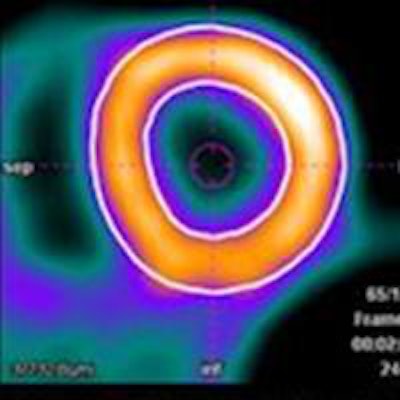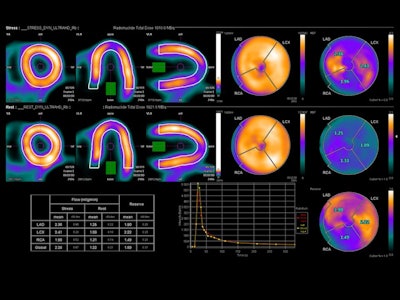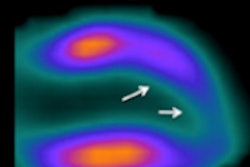
Danish researchers have found high rates of microvascular disease using PET/CT with a rubidium radiopharmaceutical in diabetes patients without symptoms of heart disease. The disease was exacerbated in the setting of albuminuria, a common condition in these patients, according to a new study in Diabetologia.
The researchers studied 60 patients with diabetes with a high prevalence of albuminaria, or the presence of the protein albumin in urine, a common symptom of kidney disease. They used rubidium PET/CT and coronary calcium scoring together to reveal microvascular dysfunction and poor cardiac flow reserve in nearly half of all patients by ruling out stenosis in the major coronary vessels, the team concluded.
Cardiac flow reserve was almost one-fifth lower in diabetes patients compared with healthy volunteers and as much as one-third lower in those with albuminuria.
"The prevalence of impaired coronary microcirculation and elevated coronary calcium score is pronounced in patients with type 2 diabetes even without known cardiovascular disease, when compared to healthy control subjects," wrote lead author Dr. Bernt von Scholten in an email to AuntMinnieEurope.com.
Von Scholten and colleagues are from Steno Diabetes Center in Gentofte, Denmark, Rigshospitalet, and the University of Copenhagen.


Patient with reduced coronary flow reserve. Images courtesy of Dr. Bernt von Scholten.
Early risks
Reduced coronary flow reserve is known to be an important, independent correlate of cardiac mortality among patients with diabetes, so identifying it is critical, the researchers noted.
Coronary disease often develops early in patients with type 2 diabetes and diabetes patients with concomitant albuminuria are at even higher risk, the authors wrote. But more research is needed to define the subsets of diabetes patients who might benefit from additional testing for asymptomatic coronary artery disease, wrote von Scholten et al (Diabetologia, 2 November 2015).
The retrospective study examined the prevalence of reduced coronary flow reserve and high coronary artery calcium scores in three groups of participants without known cardiovascular disease:
- 60 patients with type 2 diabetes, including 30 with albuminuria
- 30 patients with type 2 diabetes and persistent normal albumin rates (urinary albumin excretion rate < 30 mg/24)
- 30 controls without diabetes
The group performed a dynamic, gated, cardiac PET study using a hybrid PET/CT scanner in 3D mode (Biograph mCT 128, Siemens Healthcare) following administration of 1,100 MBq of a rubidium-82 radiotracer (CardioGen-82, Bracco Diagnostics).
The data were analyzed using software developed at Cedars Sinai Medical Center in Los Angeles, which displayed the nongated images in a polar map format divided into 17 segments per American Heart Association (AHA) recommendations.
Coronary flow reserve (CFR) measures the ability of the heart to pump more blood through the coronary vessels to the myocardium in response to increased demand, for example, while exercising. So while the controls were able to pump three times their resting blood flow in response to stress, increased blood flow on demand was severely impaired both in patients with coronary calcium and those with albuminuria.
The results showed that coronary flow reserve was higher in controls, with a CFR of 3.0 (three times resting blood flow). This compared with CFR of 2.6 in patients with normal albumin levels and only 2.0 in albuminuric patients, the authors wrote.
The asymptomatic patients with type 2 diabetes showed a high prevalence of impaired CFR and elevated coronary calcium, especially patients with albuminuria, wrote von Scholten and colleagues.
| CFR levels in diabetes patients on rubidium-92 PET | |||
| CFR | Controls | Normal albumin | Albuminuria |
| CFR | 3.0 ± 0.8 | 2.6 ± 0.8 | 2.0 ± 0.5 |
| CFR < 2.5 | n = 5 | n = 12 | n = 25 |
| CAC > 300 | n = 2 | n = 8 | n = 16* |
Coronary calcium and excessive albumin excretion were both associated with impaired coronary flow reserve.
Normal albuminuric patients had trends toward higher CFR and coronary calcium scores versus controls (p ≤ 0.023). And there was a trend toward higher coronary calcium scores in albuminuric versus normal albuminuric patients (p = 0.026).
In a multivariate regression analysis, higher urinary albumin excretion rate had a tendency to predict reduced CFR in the total patient population (p = 0.045). Adding the coronary calcium score to the mix revealed a trend (p = 0.032) toward an inverse association with lower CFR.
Even after adjusting for variables showing statistically significant correlations in the sample such as patient age, body-mass index (BMI), glomerular filtration rate, and heart rate, the difference between albuminuric patients and controls remained statistically significant ( p ≤ 0. 008) as did the difference between albuminuric and normoalbuminuric patients (p = 0.004).
"Our findings demonstrate that impaired coronary microcirculation was very frequently observed," von Scholten wrote. "In fact, more than 80% of our diabetic population with albuminuria had impaired microcirculation."
The study is the first to evaluate coronary flow reserve in patients with type 2 diabetes using cardiac rubidium-82 PET/CT, the authors wrote. In previous studies, the degree of coronary flow reserve restriction in diabetes has been linked with the magnitude of retinopathy and renal insufficiency.
Prospective studies needed
Still, the work was retrospective, and prospective studies are needed to assess the impact of rubidium-82 PET/CT findings with future cardiac events, the authors concluded. Information on other inflammation markers might reinforce the idea that rubidium-82 PET/CT works better than other techniques, they noted.
The group is currently embarking on a new study that will expand the research to 60 patients with type 1 diabetes.
"Silent ischemia/heart disease is a well-known and well-described condition in patients with diabetes," von Scholten noted in his email. "Damage in the coronary microcirculation (as assessed with coronary flow reserve) is an early sign of vascular damage. This information might be used to further emphasize the importance of intensive multifactorial treatment, with strict attention to glycemic control and aggressive management of cardiovascular risk factors, especially in patients with diabetes and concomitant albuminuria."



















